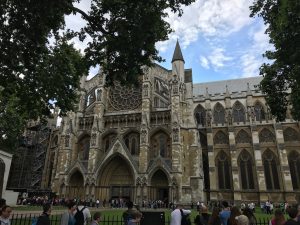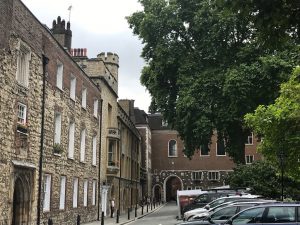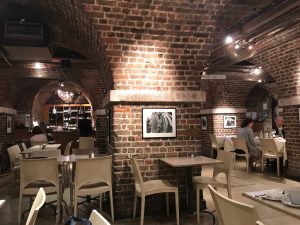
Time alters when you are a group of eight: it takes longer to get your food at a restaurant, but waiting in line seems to take less time when you’re chatting with colleagues about things like how long it takes to wait in line and how many clocks there are in the area of Westminster Abbey (a lot). We began day one at what many might call the apex of sacred and secular London: Westminster Abbey. If the word “secular” comes from the Latin meaning “of a time or age,” then Westminster, with its many surrounding clocks, is indeed secularity. And its perhaps most famous interior spaces mark locations of the profane–graves of kings and queens from 1066 into the 1950’s–along with the graves of such writers and actors as Chaucer, Dickens, and Laurence Olivier. And the cathedral charts the secularity of religion, beginning as it did as a Catholic church, then becoming Protestant with the English reformation in the sixteenth-century. At the same time, we were reminded, once an hour, that this is a space of prayer, as an announcement came over the loudspeaker about upcoming services, while also asking all of us for a minute of prayer each hour–the first time we were asked to pray for someone we know who is in need, the second time for inner peace in a hectic world. And yes, we spent a lot of time at the Abbey–close to three hours.
Tom gave a short lecture and tour of Westminster Abbey, which confirmed that visual evidence is not always trustworthy. But I believe he is posting about that.
Group members noted that Westminster Abbey was cluttered. Monica commented that it was a strong contrast to St. Peter’s in Rome, which was designed purposefully for large crowds and well thought-through spaces. Westminster Abbey, in contrast, looks more like history = grandma’s attic, as tombs and monuments seem strewn hither and yon wherever space can be found, and you can find yourself looking at a 20th century monument right above a sixteenth-century one–probably a more accurate rendering than St. Peter’s about the way that history operates.
Space constricted in the claustrophobia of the smaller chapels finally opened up blissfully, as I exited into the less-used exit of Westminster Close.

If we never made it to the crypt of Westminster Abbey, we made it to the crypt of the nearby St. John’s church for a quite secular and lovely lunch at the Footstool restaurant to compare and contrast our experiences.

Save


